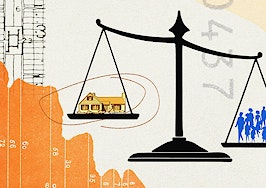This report is available exclusively to subscribers of Inman Intel, a data and research arm of Inman offering deep insights and market intelligence on the business of residential real estate and proptech. Subscribe today.
One of Derek Leman’s recent clients was ready to buy a home. They had saved up, knew exactly what they wanted and were intent on landing just the right one.
They never found it.

Derek Leman
“They looked at 30 houses,” Leman, who runs Atlanta-based 3 Options Realty with his wife, recently told Intel. “And the house had to check 12 different boxes.”
But inventory was so limited — and their wishlist so specific — that they were never able to secure their desired home, Leman said. After all of that effort, the client ultimately decided to bow out.
Their experience highlights the challenges and weirdness of today’s housing market. Aware that the market has shifted, some buyers are showing up with a long list of must-haves. But with little inventory and high interest rates making housing less affordable than ever, those same would-be buyers are also finding that there’s just not that much to actually choose from.
The result, according to agents who spoke with Intel for this story, is that today’s homebuyer is a unique breed. In many markets, gone are the days when people moved just for fun, or because they found a house with a better home office or bigger backyard. Instead, agents told Intel, consumers in their markets are mostly moving thanks to jobs or major life events, such as marriage or divorce.
Put another way — as the summer begins, the people who are willing to actually take the plunge and buy houses tend to have two things: A major need to buy a new property and the means to do so. They’re the necessity movers.
As Rick Janson, an eXp Realty agent in Denver, told Intel, “The voluntary moves are gone.”
Spring sets up the summer
To understand what’s going on right now, it’s worth reviewing what has been on the whole a fairly lackluster spring.
When the spring began, of course, hopes were high. Though there was plenty of uncertainty, many agents three months ago were starting to see what looked like a significant uptick in activity. “It feels like we’re in 2021 all over again,” one agent told Inman on the first day of spring.
But the spring did not, ultimately, prove to be like 2021.
Multiple reports over the ensuing months highlighted a market struggling mightily with extremely low inventory. That low inventory prevented prices from falling, and the homes that did hit the market were met with high demand. But as Zillow senior economist Jeff Tucker said in a report earlier this month, “many homeowners are still opting not to sell and give up historically low mortgage rates.”

Rick Janson
And of course when there’s not much for sale, there aren’t many deals to be had. Agents had a front-row seat as this situation played out.
Janson, for example, said in his area spring was “subdued” and the normal uptick never really materialized. Buyers did begin to feel like they had some power again, but at the same time inventory remained low and “people think prices are crashing but they’re not.”
“The voluntary moves, the, ‘Can we get a bigger kitchen’ — those are gone,” Jason reiterated.
Many other agents told similar stories about their own markets.

Lisa Chajet
“We expected spring to be really busy and it wasn’t,” Lisa Chajet, a broker with Coldwell Banker Warburg in New York City, told Intel. “I was bracing for a really busy spring and I didn’t have one. There’s a lot of caution out there and it seems most of my buyers who went into contract have all gotten really good deals.”
This dynamic of inadequate supply and consequently fewer transactions in the spring has set the stage for a precarious summer.
Julia Hoagland, a broker with Compass in New York City, described current conditions as characterized by “liquidity, which is good.” There are still deals happening.

Julia Hoagland
But her assessment of the market overall wasn’t glowing. She described current conditions as “strange” and dominated by consumers who are “cautious.” And she said that trade-up moves — historically something many buyers eventually did — are rare, noting that “people aren’t being as carefree as they have been in the past.”
“It’s fits and starts,” she added of current conditions. “It just seems like the market is more one of necessity than luxury right now.”
Moves of necessity
Hoagland’s take on moves of “necessity” was echoed by numerous agents who spoke to Intel.
Among them, Jim Flanagan — owner of Coldwell Banker Flanagan Realty in New Jersey — said that his area is suffering from a lack of inventory, as well as seeing “bottom-up” demand from people who would like to get into the market for the first time. But among those who already own a house, few seem to be going anywhere.

Jim Flanagan
“The one demographic we’re hoping to see later this year or next year is that move-up buyer,” Flanagan said. “We haven’t seen the move-up buyer this year. There’s a bunch of them sitting in that ranch house. They know the ranch is going to go in 24 hours and they’re going to have multiple offers. But there’s nowhere for them to go. They’re all rate-locked-in. That’s the missing component to this we have very few move-ups right now.”
Leman is also seeing more people buying out of necessity in Atlanta. The people who are willing to take the plunge right now with today’s higher rates tend to be those “who have a good bit of money saved up,” Leman told Intel.
And critically, he added, they’re the people who for whatever reason “have to buy.”
Leman went on to say that he’s seen multiple would-be buyers, when confronted with the high costs and competition for affordable properties, bow out and decide “this ain’t the time to buy a house.”
Kaye Thompson is seeing something similar in her market. A broker with Best Real Estate Company, Thompson is based in Memphis, Tennessee, but is also licensed to work in multiple surrounding states. And more than anything else, the top reason anyone is braving the current market in her area is due to changes in employment.
“Mostly it’s because of their jobs,” she told Intel. “People are getting jobs in other places, or their jobs are calling them back into work.”

Kaye Thompson
There’s also “a few divorces” in the mix of reasons people are currently willing to move, she added.
Memphis is still relatively affordable compared to many other parts of the country, and Thompson said the local economy is thriving because the area is home to both medical facilities and a major shipping distribution hub. But the main takeaway is that she too is mostly seeing moves of necessity.
“Mostly right [now] it’s the people who have to move that are still out there,” she concluded. “People who just want a different setup, they’re kind of staying put.”
Janson is adapting to this reality by specifically targeting people who have to move.
“When I’m asking for referrals,” he said, “I’m asking, ‘Who do you know who’s getting married, divorced, whose kids are going to college?'”
By the numbers
Danielle Hale, chief economist for Realtor.com, said these agents’ experiences were consistent with the market data she tracks: The people who are willing to move right now are likely those who have some pressing need to relocate. And this has played out in interesting ways.

Danielle Hale
For instance, Hale said she was surprised to discover that cross-market searches — or in other words people looking for a home in a city where they don’t currently live — have continued to rise.
“That might suggest that shoppers, the shoppers who are still in the market, are maybe a bit more flexible with location,” Hale explained.
The Realtor.com data shows that online cross-market home searches were higher in the first quarter of 2023 than they were at any other point in the last three years — including Q1 2022, when the pandemic was only just beginning.

Credit: Realtor.com
A Realtor.com report on these findings ultimately shows that “59.6 percent of listing views from the top 100 metros went to homes listed in other metropolitan areas on average.” Many online home searches seem to zero in on markets that are relatively affordable, the report notes.
Realtor.com data also shows that as interest rates rose last year, average down payments actually fell. After hovering around the 11 percent range for most of 2020, average down payments rose and eventually hit a high of 14.2 percent in June of 2022.

Credit: Inman Intel, via Realtor.com data
From that point though, down payments experienced a downward trend, falling to the 13 percent range in late 2022 and early 2023.
Hale described falling down payments as a “surprising paradoxical finding” and suggested it may be the result of exactly what agents observed: Fewer buyers stepping up to the plate.
“A lot of buyers are stepping out, so the market is a bit less competitive,” Hale said. “So that kind of creates a bit of an opening for buyers who don’t have big down payments.”
The data further shows that in absolute dollar amounts, average down payments hit a high in April 2022 at $30,855. They’ve since fallen and in May of this year sat at an average of $28,511.

Credit: Inman Intel, via Realtor.com data
Interestingly, though, the data also shows average down payments ticking back up this spring, suggesting competition remains a factor.

Unsurprisingly given the higher rates, buyers lately have also been looking to avoid mortgages. In an email to Intel, Jessica Lautz — deputy chief economist and vice president of research at the National Association of Realtors — said that “in the last month, 25 percent of all buyers purchased their home without a mortgage.”
“Since the fall of 2022,” she added, “there has been an elevated share of all-cash homebuyers in the market.”
Cash buying is influenced by people moving from expensive to cheaper metros, which gives them more buying power and the need to be competitive when there is low inventory, Lautz further explained in a recent report.

Credit: Inman Intel, via NAR data
Interestingly, though, by May of this year, the percent of all homes purchased with cash actually fell, though it remains elevated compared to historic norms. Such a dip might reflect a similar point that Hale made about down-payment size; with so many buyers tapping out, those who remain may ultimately feel less urgency to make offers entirely in cash.
NAR’s data seems to further bear this out, with Lautz noting in her report that in March 2022, sellers on average received 5.5 offers. But by May 2023, that number had fallen to an average of 2.7 offers.
Finally, it’s also worth noting average mortgage rates, because they’ve been the primary drivers of the ongoing market shift.

Credit: Inman Intel, via Federal Reserve Bank of St. Louis data
Data from the Federal Reserve Bank of St. Louis shows that rates remain elevated, though they’ve retreated somewhat from their high points. That won’t come as a surprise to real estate industry observers, but it’s notable that all of the charts above have roughly the same shape, highlighting how interconnected all of these factors are.
The takeaway from all of this is as the summer begins, cash offers are high compared to historic norms, down payments are ticking up and rates are still high. And such findings add another dimension to the profile of people who are willing to buy right now: It’s not just the people who need to move, but also the people who have the resources — in the form of cash — to do so.
So who is exactly buying in this environment?
Several agents who spoke to Intel said that one demographic that appears to be moving right now is baby boomers — many of whom are now both empty nesters and flush with equity in their current homes. Chajet, for instance, said that she has seen baby boomers looking anew at urban living.
“I’m finding that there’s a lot of empty nesters who moved to the suburbs for the schools and want to come back to New York,” she explained.
Flanagan noticed similar demographic trends in his area.
“The baby boomers, they’re trying to make their final purchase, or near final purchase, with as much cash as possible,” he said.
Lautz believes there’s something to this, saying not only that baby boomers are today’s largest cohort of homebuyers, but that their rise “is a reversal of an eight-year trend where millennials were the largest generation of home buyers.”
“Baby boomers have accrued equity as homeowners and are able to make housing trades more comfortably,” she explained. “Millennials are often first-time buyers and struggling to enter the homebuying market.”

Credit: National Association of Realtors
NAR’s data also shows that baby boomers are making more cash purchases than any other cohort except for the Silent Generation.
Many of the agents who spoke to Intel for this story mentioned working with would-be buyers in other age demographics. Baby boomers are certainly not the only people buying houses right now. But in general, the agents also found that baby boomers are the ones both with the means to move and who are facing life events — divorce, becoming empty nesters, the death of a partner, etc. — that are forcing their hands.
Younger and middle age buyers such as millennials, on the other hand, might have good reasons to move but in some cases don’t have the boomers’ resources.
Flanagan offered a case study in this phenomenon. He said he recently worked with a young woman in her 30s who, due to her job, needed to live near a local airport. Like other buyers in that age range, the woman — who had never owned a house before — was “reluctant to wait” to buy and wanted the peace of mind that she felt would come with homeownership.
Flanagan worked to find her something at the affordable end of the price spectrum. But in the end, peace of mind wasn’t enough and the woman ultimately put her plans on hold — a decision that captures so much of what’s going on right now in real estate.
“She renewed her lease,” Flanagan said of the woman’s decision to keep renting. “She had to renew her lease and wait to see if things change.”













